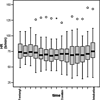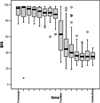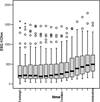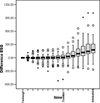Prospective study comparing skin impedance with EEG parameters during the induction of anaesthesia with fentanyl and etomidate
- PMID: 20452883
- PMCID: PMC3352044
- DOI: 10.1186/2047-783x-15-2-47
Prospective study comparing skin impedance with EEG parameters during the induction of anaesthesia with fentanyl and etomidate
Abstract
Objective: Sympathetic stimulation leads to a change in electrical skin impedance. So far it is unclear whether this effect can be used to measure the effects of anaesthetics during general anaesthesia. The aim of this prospective study is to determine the electrical skin impedance during induction of anaesthesia for coronary artery bypass surgery with fentanyl and etomidate.
Methods: The electrical skin impedance was measured with the help of an electro-sympathicograph (ESG). In 47 patients scheduled for elective cardiac surgery, anaesthesia was induced with intravenous fentanyl 10 mug/kg and etomidate 0.3mg/kg. During induction, the ESG (Electrosympathicograph), BIS (Bispectral IndeX), BP (arterial blood pressure) and HR (heart rate) values of each patient were recorded every 20 seconds.The observation period from administration of fentanyl to intubation for surgery lasted 4 min. -
Results: The ESG recorded significant changes in the electrical skin impedance after administration of fentanyl and etomidate(p <0.05). During induction of anaesthesia, significant changes of BIS, HR and blood pressure were observed as well (p <0.05).
Conclusions: The electrical skin impedance measurement may be used to monitor the effects of anesthetics during general anaesthesia.
Figures





Similar articles
-
Induction of anaesthesia in patients with coronary artery disease: a comparison between sevoflurane-remifentanil and fentanyl-etomidate.Anaesth Intensive Care. 1999 Aug;27(4):363-8. doi: 10.1177/0310057X9902700405. Anaesth Intensive Care. 1999. PMID: 10470389 Clinical Trial.
-
Anaesthesia for cardioversion: a prospective randomised comparison of propofol and etomidate combined with fentanyl.Hellenic J Cardiol. 2011 Nov-Dec;52(6):483-8. Hellenic J Cardiol. 2011. PMID: 22143010 Clinical Trial.
-
The effect of esmolol on the QTc interval during induction of anaesthesia in patients with coronary artery disease.Anaesthesia. 2009 Mar;64(3):246-50. doi: 10.1111/j.1365-2044.2008.05754.x. Anaesthesia. 2009. PMID: 19302635 Clinical Trial.
-
Sevoflurane-fentanyl versus etomidate-fentanyl for anesthetic induction in coronary artery bypass graft surgery patients.J Cardiothorac Vasc Anesth. 2000 Aug;14(4):421-4. doi: 10.1053/jcan.2000.7935. J Cardiothorac Vasc Anesth. 2000. PMID: 10972608 Clinical Trial.
-
Total intravenous anaesthesia (TIVA) in paediatrics: advantages and disadvantages.Paediatr Anaesth. 1998;8(3):189-94. doi: 10.1046/j.1460-9592.1998.00759.x. Paediatr Anaesth. 1998. PMID: 9608961 Review. No abstract available.
Cited by
-
Can changes in skin impedance be used to monitor sedation after midazolam and during recovery from anesthesia?Physiol Res. 2021 Apr 30;70(2):265-272. doi: 10.33549/physiolres.934621. Epub 2021 Mar 8. Physiol Res. 2021. PMID: 33676384 Free PMC article. Clinical Trial.
-
Sedation and analgesia with fentanyl and etomidate for intrathecal injection in childhood leukemia patients.Medicine (Baltimore). 2015 Jan;94(1):e361. doi: 10.1097/MD.0000000000000361. Medicine (Baltimore). 2015. PMID: 25569654 Free PMC article. Clinical Trial.
References
-
- Hess WC, Ohe A. Does ketamine/propofol anesthesia possess antiarrhythmogenic quality? A perioperative study in aortocoronary bypass patients. Eur J Med Res. 2001;6:543–550. - PubMed
Publication types
MeSH terms
Substances
LinkOut - more resources
Full Text Sources
Miscellaneous

